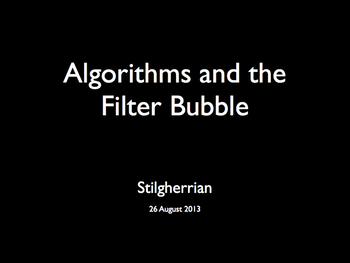 As foreshadowed, on Monday I delivered an updated version of my guest lecture at the University of Technology Sydney, “Algorithms and the Filter Bubble”. And here it is.
As foreshadowed, on Monday I delivered an updated version of my guest lecture at the University of Technology Sydney, “Algorithms and the Filter Bubble”. And here it is.
There’s quite a few changes from the lecture I gave in March, because I wanted to update some key examples.
In fact there’s two versions of the lecture, because I presented it twice — once at 0900 and once at 1300 — and some of the content was improvised around my moderately detailed notes. So I’ll bring you both versions. This is the first, with full audio and the slides.
The repeat of the lecture later in the day was slightly different.
There’s links to all the references over the fold.
As previously, the recording picks up immediately after I was introduced by lecturer, Dr Belinda Middleweek. A transcript may or may not follow at some point in the future.
The audience was primarily first and second year students at the beginning of their media studies degrees. Again, it seems that almost all of this material was brand new to them.
Podcast: Play in new window | Download (Duration: 48:40 — 32.1MB)
[If a transcript ever becomes available, this is where it will appear.]
This work is made available under a Creative Commons BY-NC-SA license. This presentation may be re-used for non-commercial purposes within the terms of the Creative Commons license. The non-commercial and share-alike conditions are required to adhere to the licensing of the imagery used. Please contact me if you require an alternative version. As a minimum, attribution should read: “Source: Stilgherrian.” Online versions must link the word Stilgherrian to the website at stilgherrian.com.
References
- The Collusion plugin for the Firefox web browser, which maps the relationships between the third-party tracking code you encounter in your web browsing.
- Cookies, the fundamental building-block of web tracking technology.
- Some of my recent articles about data mining and re-identification for supposedly anonymous data.
- Official information about Australia’s new privacy laws, which come into force in 12 March 2014.
- The ProPublica article, Everything We Know About What Data Brokers Know About You, from March 2013.
- How Companies Learn Your Secrets, by New York Times journalist Charles Duhigg, 16 February 2012. This includes the example of Target being able to determine when a woman has become pregnant from her shopping list.
- Gaydar: Facebook friendships expose sexual orientation, by Carter Jernigan and Behram F T Mistree, First Monday, 5 October 2009.
- Stats Monkey, the 2009 project in robot-written sports news stories from the Intelligent Information Laboratory at Northwestern University. That project page contains links to media coverage of the project.
- Narrative Science’s ‘Robot Journalists’ Now Tackling Real Estate, Media Bistro, 12 September 2011.
- Earthquake: 3.2 quake strikes near San Simeon, a computer-generated story from the LA Times, 1 February 2013.
- Narrative Science, one of the leaders in computer-generated news.
- Automated Insights, another such leader.
- My Crikey article Twitter mapping and how we choose our own adventure from 23 May 2012, linking to the work of the ARC Centre of Excellence for Creative Industries and Innovation at the Queensland University of Technology.
- Mapping Online Publics, the ongoing blog of that project.
- My article Prepare for the attack of the politiclones! on fake Twitter followers and Australian politics, 15 August 2013.
- Videos from the US Naval Research Laboratory’s Cognitive Robots project. Of particular interest is Robotic Secrets Revealed, Episode 002 (Hiatt, Harrison, Lawson, Martinson, & Trafton, 2011).
- How well does music predict your politics? by Brian Whitman, 11 July 2012.
- Steve Jobs Offers World ‘Freedom From Porn’, Gawker, 15 May 2010.
- Apple Rejects App That Tracks US Drone Strikes, Wired, 30 August 2012.
- My article The Facebook experiment, 23 March 2012.
[Update 29 August 2013: Fixed broken link to the slides. Update 13 March 2014: I will be presenting updated versions of this lecture again in 2014. The next one is on Monday 7 April at 1000.]

> A transcript may or may not follow at some point in the future.
Please, please, put up a transcript — for the record, so it can be found.
Even a rough first cut draft transcript would be searchable, and readers can help clean it up.
@Hank Roberts: I somehow missed your comment. You’re right about a transcript making the lecture easier to find, but I just didn’t find the 4 to 5 hours needed to do it. Given that the lecture will be updated in just a few weeks, I’ll try ti organise it for this time.